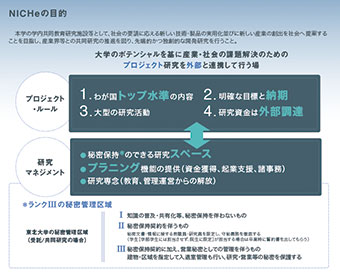Academy User vol.9
Tohoku University
New Industry Creation Hatchery Center (NICHe)
Engaged in Research on Earthquakes, Automated Driving, and HMI as Main
Subjects with Originally Advanced DS
DS to Link Accumulated Data and UC-win/Road Constructed for Project of
Ministry of Education, Culture, Sports, Science, and Technology
Academy Information
New Industry Creation Hatchery Center, Tohoku UniversityURL : http://www.niche.tohoku.ac.jp/
Location : Aoba-ku, Sendai city, Miyagi, Japan
Research Field : state-of-the-art, creative development and research on the fi elds of life science, environment, information
communications, nanotechnology, and materials in cooperation with industrial communities.
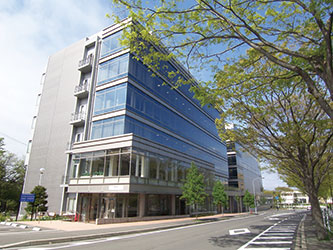 |
 Main building of New Industry Creation Main building of New Industry Creation Hatchery Center (NICHe), Tohoku University |
Three areas of research and development are positioned as the cores of
their activities: research contributing to restoration, disaster mitigation,
and disaster prevention, all of which share "earthquakes" in
common as a key word; automated driving that had already been studied prior
to that; and HMI (human machine interface) focusing on how to make up the
interactive part between a human and an automobile in manmachine systems.
The industry-academiagovernment network including the local industrial
circle is an important framework to drive them, says Associate Professor
Shigeyuki Yamabe, New Industry Creation Hatchery Center, Tohoku University.
As part of them, he has been participating in the Next-generation Energies
for Tohoku Recovery (NET) Project sponsored by Ministry of Education, Culture,
Sports, Science and Technology-Japan (MEXT) since when he belonged to Tokyo
University. After moving to Tohoku University, he adopted "UC-win/Road"
FORUM8's 3D real time VR to which he had been paying attention before in
2015 through the "Research and development on management system for
mobility and energy " (performed by Tokyo Univ. and Tohoku Univ.)
in the project, along with a data converter (OpenFlight format converter)
for using data obtained from simulators produced by another manufacturer.
Position of the Tagajo Base of NICHe
| It was 2012, one year later of Great East Japan Earthquake, that Associate
professor Yamabe moved from Tokyo University to Tohoku University. It is
known that victims of tsunami increased because a lot of people had brought
about a traffic jams in many places of the coastal area in an attempt to
escape by car. Besides, despite the experience, people tended to escape
by car when a large aftershock occurred one and a half years later. Therefore,
how to let cars to escape to safe places without traffic jams in the time
of an earthquake was his first appointed study theme in Tohoku, he reviewed. New Industry Creation Hatchery Center (NICHe), Tohoku University was established in 1998 for the purpose of promoting industry-academia joint research and making state-of-the-art and creative research and development in order to propose new technologies and creation of new industrial fields to meet the social needs. As the basis of specific activities, NICHe started with research and development projects in 7 fields at its foundation. Since then, it has been expanding its research system steadily. Today, more than 20 industry-academia joint projects over 4 fields of life science, environment, nanotechnology / materials, and IT (information technology), are going on, mainly at Aobayama Campus (Aoba-ku, Sendai-shi) of Tohoku University. |
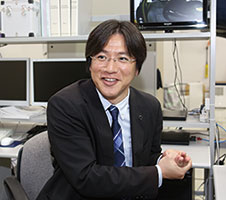  Associate professor Associate professor Shigeyuki Yamabe |
On the other hand, Great East Japan earthquake that hit wide areas in and
around Tohoku region in March 2011 also caused inundation at the Sendai
Technology Center (Tagajo-shi, Miyagi Pref.), Sony Corporation, with serious
damages such as machinery loss. This made the company review the role of
the Center and broke up its production into other factories. Since this
brought about a vacant building in the Center, "Manufacturing base
for recovery in Tohoku" scheme using some section of the building
came up for quick recovery of the region. Tohoku Univ. and concerned prefecture,
cities, and industries held consultations many times to realize the scheme.
As a result, "Miyagi Reconstruction Park" was founded in October
2011, which is a base for creating innovation operated and managed by Miyagi
Organization For Industry Promotion. Along with this, NICHe also established
its research base in the park.
6 months later in the fiscal year of 2012, Associate Professor Yamabe took
the present position of NICHe. He has been working on research and development
with the three areas mentioned in the beginning based on the Tagajo Base
of the research project on next generation advanced mobility system in
the park.
Flow of his Researches Utilizing the Features of DS
Before moving to Tohoku University, Associate Professor Yamabe took part in "Development of Energy-Saving ITS (Intelligent transport system) Technology (Energy ITS)" (2008-2012 fiscal year) by New Energy and Industrial Technology Development Organization (NEDO). In relation to technology for automated driving, he used a driving simulator (DS) to construct events that could not be confirmed by real vehicle experiments, such as automated truck platoon to see how tense the drivers become with short distance between vehicles, or what degree of distance between vehicles can make the driver avoid danger even if there are any malfunctions in the automated driving system. Using this, he tried to evaluate the result from the drivers' biological signals such as heartbeats and perspiration. He also made evaluation of the design and operability of HMI to be actually mounted on the real vehicle using the same DS.
Another activity he started with when he was working in Tokyo Univ., with which he found an occasion to move to Tohoku Univ., was "Research and Development on Management System for Mobility and Energy " of the Next-generation Energies for Tohoku Recovery (NET) Project sponsored by MEXT. This is a management system studied and developed jointly by Tokyo Univ. and Tohoku Univ. for integrating energy and mobility, which had been managed separately so far, in order to support disaster-resilient and sustainable development of local areas. In this work, Associate Professor Yamabe aimed at making prior evaluation using DS instead of real vehicle experiments with which it was difficult to build up a system using Electric Vehicles (EV).
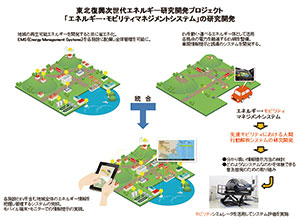
 "Research and development on management
"Research and development on managementsystem for mobility and energy", Nextgeneration Energies for Tohoku Recovery
(NET) Project sponsored by MEXT
"While a test subject travels by car, you can give tremors of an earthquake there." Like this, he expresses one of the excellent features of DS actually felt through a series of projects. In other words, since no one can tell when an earthquake occurs, it was difficult until then to study how drivers behave when an earthquake happens while driving. Using DS, however, made it possible to make diverse studies: for example, to study how drivers react when setting conditions simulating an earthquake, or what kind of information should be given to let the driver to understand it and quickly move to take an appropriate action.
In addition, as mentioned before, evacuation by vehicle attracted attention in the case of the Great East Japan Earthquake. On the contrary, it was common to perform a disaster drill on foot conventionally. However, there must be various ways of evacuating if an earthquake (and its accompanying tidal wave) occurs when one is travelling by car. Considering this, he and others constructed a mechanism for experiencing disasters on DS for studying how to improve the safety of evacuation by car. Through verification or experiences with game feeling using this, they are also proceeding a study on the most effective method of presenting information to drivers.
He says, "Evacuation sites at the time of an earthquake are determined within the region to a certain degree. For example, since it is possible to navigate the route from where you are now to the evacuation site, I hope the route can be proposed (to the driver in an emergency) in the best possible form."
Flow of Introducing UC-win/Road and Features of DS for the Purpose of Research
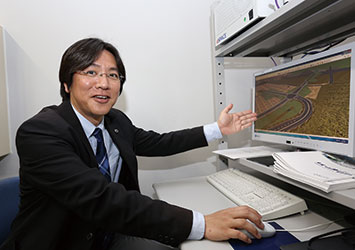
 Operation of UC-win/Road with the adopted OpenFlight format converter
Operation of UC-win/Road with the adopted OpenFlight format converter"Since we verify various things using a simulator in the MEXT project ("Research and Development on Management System for Mobility and Energy, we had to represent the real space in CG. However, it took much time and efforts to create CG including (representation of) gradients."
He had been facing such a challenge since he was working on the project when he belonged to Tokyo Univ. Then he paid attention to UC-win/Road, which was provided with contents necessary for operations, in that it allowed construction of diverse worlds within virtual spaces of CG relatively in short time and with ease. Although he had been considering its adoption since several years before, he gave up introducing it because of the difference in the file formats with the software produced by other company and owned by him.
Then after moving to the Tagajo Base of the research project on next generation advanced mobility system and preparing facilities from the scratch, he again came upon an idea of utilizing UCwin/Road when he was urged to represent the Ishinomaki urban area of Miyagi prefecture etc. in 3D VR immediately in order to develop a system that conformed to the actual situation of the site as part of the project 2 years ago. Finally, it was adopted last year (2015).
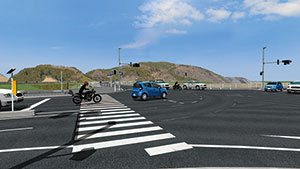
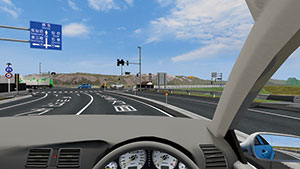
by linking data converted and constructed using UC-win/Road
"Personally, the best feature of this is capability of creating gradients
easily (as it had been a significant burden in using the existing software)."There
are many mountainous regions in Tohoku district. If one creates gradients
one by one by the conventional method, it alone might take several months.
In aiming at reducing this burden, it was strongly desired to use UC-win/Road.
In addition, the problem in linking data created with the existing software,
a former obstructing factor to introduction of UC-win/Road, was solved
by using OpenFlight format converter in between. It allowed reduction of
time in constructing a scenario based on UC-win/Road.
Besides, since Tohoku district is an earthquake-prone region, high-definition rear-projection display unit was adopted instead of a common screen to hang from the ceiling which is apt to cause trouble or failure at the time of an earthquake. This display unit is one of the features of the DS owned by Associate Professor Yamabe. Moreover, he altered the system so that images can be displayed without trapezoidal distortion correction to avoid delay. The full body of a secondhand real vehicle he and others had prepared was mounted on a 6-axis oscillation device produced by other companies. This is their original installation method that takes account of transfer of vibration of a car, which voids the function of suspension while leaving its mechanism, allowing the vibration from the oscillation device to be transferred to the vehicle body through the suspension part. Furthermore, as the result of joint development with Tokyo Univ., they introduced a method for synthesizing the road of CG and the background taken from the photographed image using a computer to show on the display.
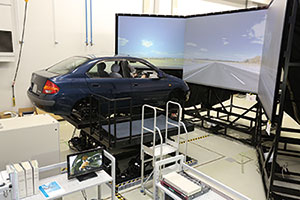
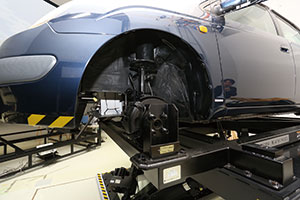
New Development of Use of UC-win/Road, and Expectation Towards Future
"(Owing to development of OpenFlight format converter) materials produced by (the software of) two different companies can be operated at the same time now (though they were forced to operate them by separate systems before). This is an epoch-making affair," says Associate Professor Yamabe, mentioning its significance.
In addition, one of the themes he is now working on with the greatest weight
is a countermeasure for elderly people's wrong-way driving. In specific,
actual places of the problem are represented in VR (virtual reality) using
UC-win/Road etc. After some countermeasures are taken, travelling experiments
are conducted with Ministry of Land, Infrastructure, Transport and Tourism
(MLIT). It is planned to introduce the measures with which quantitative
effects are confirmed into the actual spots.
Moreover, using rich contents of UCwin/Road, he plans to represent a variety
of dangerous scenes created by the simulator more realistically, which
are impossible to create using the real vehicle. He says that he would
like to use this in the process of the countermeasure to prevent wrong-way
driving, biological monitoring, or development of automated driving technologies.
On the other hand, he says that since not a few local companies have UC-win/Road as it is easy to use, those companies having no DS are hoping to have not only a desk test but also a test with what actually moves. As part of the activities of the project by MEXT he is working on ("Next Generation Automobiles in Miyagi Area,”, Regions focused on strengthening international competitiveness, Great East Japan Earthquake Disaster Recovery Assistance, Regional Innovation Strategy Support Program), a framework is set in which DS is positioned as a shared facility for companies to use. He said that in this sense he expected FORUM8 to play a leading role in developing a framework so that organizations having DS and software or software only can cooperate with each other as needed.
